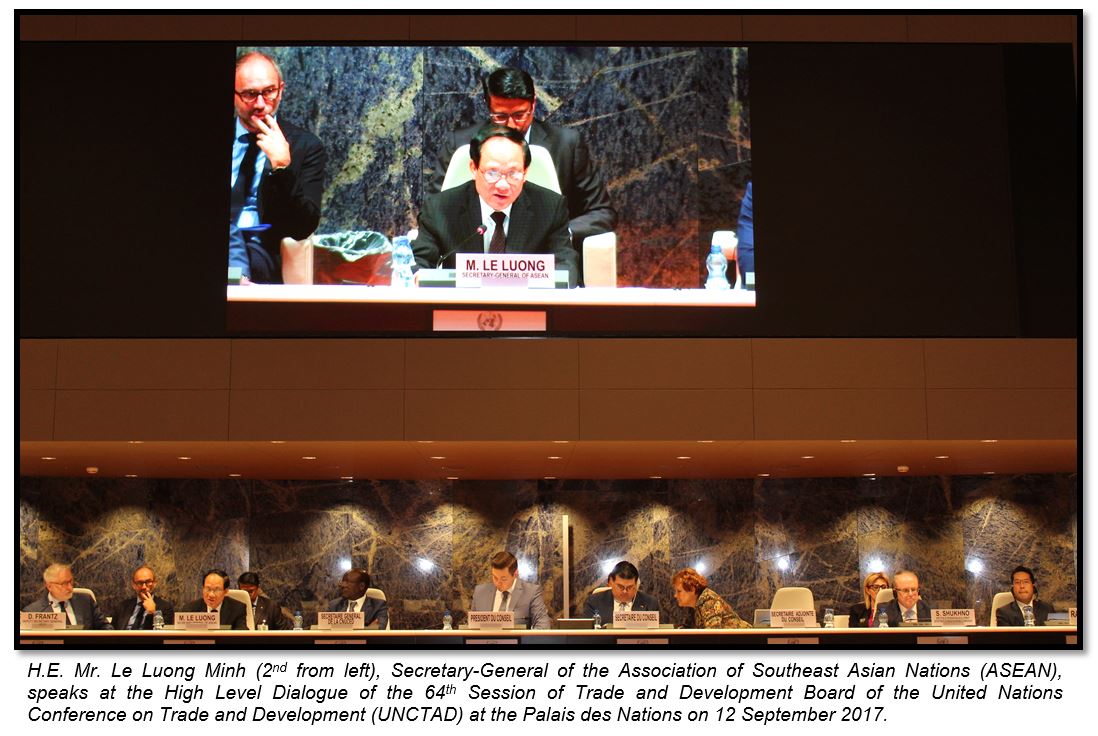ASEAN SECRETARY-GENERAL HIGHLIGHTS ASEAN INTEGRATION AT UN CONFERENCE ON TRADE AND DEVELOPMENT

13 September 2017, Wednesday, Geneva, Switzerland – H.E. Mr. Le Luong Minh, Secretary-General of the Association of Southeast Asian Nations (ASEAN) served as a panelist at the High Level Dialogue of the 64th Session of Trade and Development Board of the United Nations Conference on Trade and Development yesterday, 12 September.
The topic for this year’s dialogue was “Is the world integrating or disintegrating?”
Mr. Duog Frantz, Deputy Secretary-General of the Organisation for Economic Cooperation and Development (OECD), H.E. Ambassador Carl Hallergard, Deputy Permanent Representative of the European Union (EU) Permanent Delegation to the UN, and Mr. Sergey Shukhno, Director of Integration Development Department of the Eurasian Economic Commission, joined him in the panel.
In his remarks, the ASEAN Secretary-General said that the year 2017 marks the 50th anniversary of the Association of South East Asian Nations (ASEAN) and ASEAN’S theme for the year is Partnering for Change, Engaging the World. For ASEAN therefore, the world is integrating.
He added that ASEAN was founded with the expressed goals of cooperation in the economic, social, cultural, technical, educational, and other fields. Members proclaimed that it is the collective will of the nations of Southeast Asia to bind themselves together in friendship and cooperation and, through joint efforts and sacrifices, secure for their peoples and for posterity the blessings of peace, freedom and prosperity.
Also during the High-Level Dialogue, Dr. Mukhisa Kituyi, Secretary-General of the United Nations Conference on Trade and Development (UNCTAD), praised ASEAN as a model for regional integration with its pragmatic approach.
ASEAN’s integration efforts moved ahead in 2015, when the ASEAN Economic Community was established (AEC). This was a significant milestone in terms of economic regional integration. In 2015 the combined ASEAN economies offered a large market of USD2.4 trillion with a population of over 629 million, making ASEAN the 6th largest economy in the world and 3rd in Asia with the 3rd highest population after China and India. In the same year, ASEAN attracted USD$120 billion in FDI, 62.5% of which was in the services sector.
The ASEAN Secretary-General also talked about the Regional Comprehensive Economic Partnership (RCEP) that is currently being negotiated. He mentioned that “RCEP’s aim is to enhance economic linkages and strengthen trade and investment related activities. Negotiations were launched in 2012 are now being finalized. When it is completed, RCEP will cover trade in goods, services, investment, economic and technical cooperation, intellectual property, competition, dispute settlement, e-commerce, SMEs, among others. RCEP is therefore another integration effort being pursued by the ASEAN countries.”
The Trade and Development Board meet every year to tackle the development challenges of the day. The theme of this year’s High Level Dialogue, aimed to tackle the seeming return to protectionist and nationalist sentiment to the detriment of free trade and globalization. The ASEAN Secretary-General, in his capacity as a panelist, showed that multilateralism and regional integration are still being pursued in the ASEAN region and that this is a key to the promotion of the development of ASEAN Member States. END
